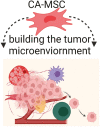Carcinoma-Associated Mesenchymal Stem/Stromal Cells: Architects of the Pro-tumorigenic Tumor Microenvironment
- PMID: 35583414
- PMCID: PMC9406606
- DOI: 10.1093/stmcls/sxac036
Carcinoma-Associated Mesenchymal Stem/Stromal Cells: Architects of the Pro-tumorigenic Tumor Microenvironment
Abstract
The interaction between tumor cells and non-malignant hosts cells within the tumor microenvironment (TME) is critical to the pathophysiology of cancer. These non-malignant host cells, consisting of a variety of stromal, immune, and endothelial cells, engage in a complex bidirectional crosstalk with the malignant tumor cells. Mesenchymal stem/stromal cells (MSCs) are one of these host cells, and they play a critical role in directing the formation and function of the entire TME. These MSCs are epigenetically reprogrammed by cancer cells to assume a strongly pro-tumorigenic phenotype and are referred to as carcinoma-associated mesenchymal stem/stromal cells (CA-MSCs). Studies over the last decade demonstrate that CA-MSCs not only directly interact with cancer cells to promote tumor growth and metastasis but also orchestrate the formation of the TME. Carcinoma-associated mesenchymal stem/stromal cells can differentiate into virtually all stromal sub-lineages present in the TME, including pro-tumorigenic cancer-associated fibroblasts (CAF), myofibroblasts, and adipocytes. carcinoma-associated mesenchymal stem/stromal cells and the CAFs they produce, secrete much of the extracellular matrix in the TME. Furthermore, CA-MSC secreted factors promote angiogenesis, and recruit immunosuppressive myeloid cells effectively driving tumor immune exclusion. Thus CA-MSCs impact nearly every aspect of the TME. Despite their influence on cancer biology, as CA-MSCs represent a heterogenous population without a single definitive marker, significant confusion remains regarding the origin and proper identification CA-MSCs. This review will focus on the impact of CA-MSCs on cancer progression and metastasis and the ongoing work on CA-MSC identification, nomenclature and mechanism of action.
Keywords: mesenchymal stem cell; metastatic niche; stroma; tumor microenvironment.
© The Author(s) 2022. Published by Oxford University Press.
Figures




References
-
- Wu T, Dai Y.. Tumor microenvironment and therapeutic response. Cancer Lett. 2017; 387:61-68. - PubMed

